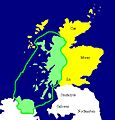History of local government in Scotland facts for kids
The history of local government in Scotland is about how Scotland has been managed and organized over many centuries. It's a story of old ways of governing changing into new ones, especially since the mid-1900s. Local government means how towns, cities, and regions are run by local people, not just the main national government.
Contents
Early Scottish Government: Shires and Sheriffs
The story of local government in Scotland really begins with the creation of areas called shires or counties. These shires were managed by a person called a sheriff. The word "sheriff" comes from "shire reeve," which was like a local manager.
King Malcolm III started using sheriffs around the 11th century. He wanted to change the older, more traditional Scottish ways of governing. He brought in ideas from the Anglo-Saxons and Normans, which involved a system called feudalism. His sons, Edgar, Alexander I, and especially David I, continued this work. David I finished dividing Scotland into these sheriffdoms.
How Local Power Worked in Medieval Scotland
In the later Middle Ages, Scotland was governed by a mix of traditional family-based lordships and a smaller system of royal offices. Until the 1400s, powerful families, known as clans, largely controlled their own areas. New powerful families like the Douglases and Crawfords also gained land after the Wars of Independence.
The Stewarts became very powerful and eventually took control of the Scottish crown. After some conflicts, by the 1460s, the king had much more power. The king could now govern many parts of the Lowlands using the sheriff system, rather than relying on semi-independent lords.
In the Highlands, King James II created two new powerful earldoms for his friends: Argyll for the Campbells and Huntly for the Gordons. These helped to control the huge Lordship of the Isles built by the Macdonalds. King James IV eventually took control of the Macdonald lands in 1493, ending their great power.
Growing Royal Control Over Local Areas
From the 1500s, the central government became much more involved in local matters. They started to control local disputes and collect taxes more regularly. In 1607, a system of Justices of the Peace was set up, similar to England. These officials dealt with smaller crimes and issues.
King James VI was not a fan of the Highland culture. He even sent people from Fife to live in parts of the Highlands. He also made Highland chiefs accept Lowland language and culture through the Statutes of Iona in 1609. From the 1600s, the shires began to do more than just judicial work; they took on wider local administration roles.
In 1667, officials called Commissioners of Supply were appointed in each shire. Their job was to collect a land tax called the cess. Local church parishes also became important. In the early 1700s, they had to help people who were very poor, especially during times of famine like in 1740. This stopped people from wandering the roads and causing trouble.
Local church groups, called kirk sessions, also helped control people's behavior. These groups, made up of church elders, dealt with moral and religious issues. Smaller local courts, called court barons, also helped settle minor disputes about property or people. These courts gave local landowners a lot of power to control the people in their communities.
Modern Changes in Local Government
For a long time, towns, known as burghs, had a lot of independence. In 1858, police forces were set up in each county under the Police (Scotland) Act 1857.
Creating County Councils in 1890
A big change happened in 1890 with the Local Government (Scotland) Act 1889. This law created a standard system of county councils across Scotland. These new councils took over many jobs from older groups, like collecting taxes and managing roads. They also took on many duties from the Justices of the Peace.
Changes Between 1890 and 1975
Between 1890 and 1929, there were parish councils and town councils. But in 1929, the Local Government (Scotland) Act 1929 changed things again. The jobs of parish councils went to larger district councils. Also, towns were divided into "large burghs" (with over 20,000 people) and "small burghs." This Act also created some joint county councils, like for Perthshire and Kinross-shire, and for Morayshire and Nairnshire.
This system was updated again in 1947 by the Local Government (Scotland) Act 1947. This created new administrative areas called 'counties', 'counties of cities', 'large burghs', and 'small burghs'. These areas stayed in place until 1975.
Big Changes in 1975 and 1996
In 1969, a special group called the Royal Commission on Local Government in Scotland suggested that Scotland needed much larger local councils. They thought this would work better than the small county-based councils. Most of their ideas were put into law by the Local Government (Scotland) Act 1973. This law created a system of regions and districts in 1975.
However, this system only lasted for 21 years. In 1996, another law, the Local Government etc. (Scotland) Act 1994, changed things again. The regions and districts were reorganized into new, all-purpose local areas called council areas. This is the system that Scotland largely uses today.
Images for kids
-
Map of Scotland, around 580–600 AD. Areas of the Picts are yellow. Cumbrian areas are white. Gaelic areas are green.





